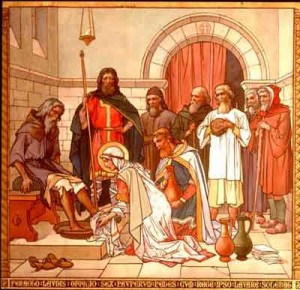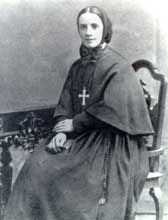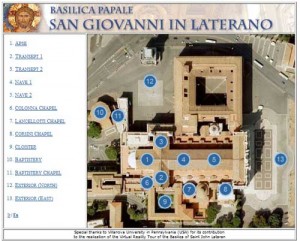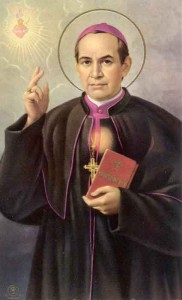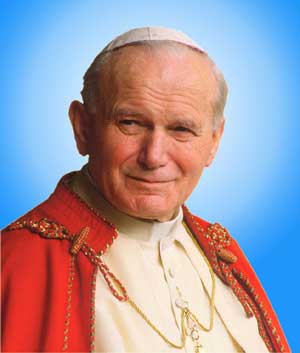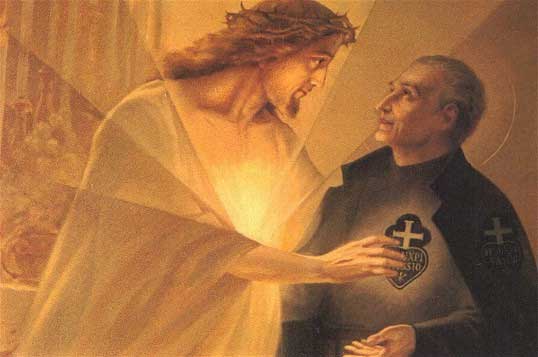A Queen of Scotland!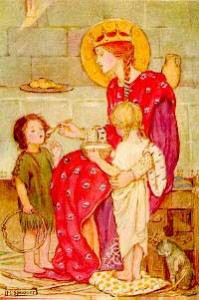
Margaret was born c. 1045 and was the niece of King Edward the Confessor of England. She was raised in Hungary and lived with her exiled father, Edward Atheling, her mother, Agatha, her brother, Edgar, and her sister, Christian. They returned to England in 1054. Early chronicles tell us that she read the scriptures in Latin, learned French and was trained in English needlework.
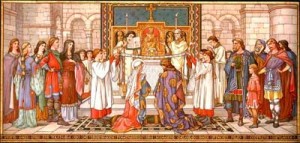 Marriage of St Margaret
Marriage of St MargaretMargaret married Malcolm III ‘Canmore’ of Scotland in c.1070. Margaret would have been about 24 years of age and Malcolm about 47. Ancient chronicles tell us that Margaret was more prepared for the cloister than the crown. However, Malcolm won her over and they were married in Dunfermline, then the seat of the Scottish kings.
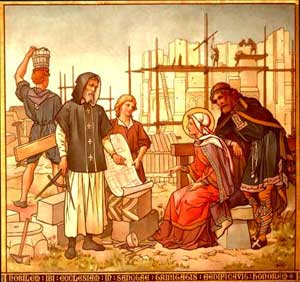
Margaret had a significant influence on early Scotland. Although she was a patron of the existing celtic church, she also introduced to Scotland the Benedictines from Canterbury and had the Priory Church built which would eventually become Dunfermline Abbey. Margaret also had a chapel built at Edinburgh Castle and the church at Iona rebuilt after Viking attacks.
Washing the feet of the poor
Margaret was very pious and carried out many works of charity. She visited and cared for the sick and had hostels built for the poor. It was her custom that the poor should visit her every morning and be seated around her to receive alms. (more…)
Tags: benedictine, catholic, catholic podcast, catholic prayer, cathollc spirituality, celtic church, england, Malcolm III, mother, scotland, st margaret, St Margaret Margaret, St. Margaret of Scotland, women of the middle ages
This entry was posted on Wednesday, November 16th, 2011 at 12:04 am
You can follow any responses to this entry through the RSS 2.0 feed.
Mother Frances Xavier Cabrini: America’s Patron Saint of Immigrants
As debates rage nationally and locally over immigrant’s rights, we are well served to remember that – ultimately and with very few exceptions – all Americans are immigrants in one form or another. At the Statue of Liberty’s pedestal, the American ideal is reflected eloquently in a poem by Emma Lazarus that begins: “Give me your tired, your poor, your huddled masses yearning to breathe free…” Ideology and dialogue alone, however,
provide little visible relief to immigrants. Help often comes from individuals, and for many Italian immigrants in late 19th America, this support came from Saint Frances Xavier Cabrini.
Widely recognized as the first American citizen canonized by the Roman Catholic Church, she is also acknowledged as the Patron Saint of immigrants. She gave hope to those desperately seeking help, offering assistance in both their material and spiritual needs.
Born Maria Francesca Cabrini on July 15, 1850, she was the tenth child of Agostino Cabrini and Stella Oldini. Her difficult birth, premature by two months, affected her health throughout her life. Many of siblings, however, would not survive adolescence. Her father farmed as her mother tended to the children in Sant’Angelo Lodigiano, a small village sited on the plains of Lombardy south of Milan.
Maria’s life found its direction early. Nightly, her father read to the family, often recounting stories of great Catholic missionaries. Especially appealing for Maria were the tales of Chinese missions, and she hoped to become a Franciscan missionary. At the age of 13, she enrolled as a boarding student in the Normal School located in the commune of Arluno. Graduating in 1868 and certified as a teacher, she remained in Arluno, living in the convent with the religious sisters who ran the school.
In 1877, at the age of 27, she was able to take religious vows and became the Mother Superior of the House of Providence orphanage in another Lombardian commune, Codogno. In a tribute to the evangelizing Jesuit, Frances Xavier, Maria added Xavier to her name. Within three years, she helped establish a new order, the Missionary Sisters of the Sacred Heart. The order helped to create homes, a school and a nursery, and their good works became known to the Bishop of Piacenza, Giovanni Scalabrini.
By the late 19th century, thousands of Italians had arrived in the United States, with many making New York City their home. They suffered tremendous hardships in their new country. Viewed contemptuously by most Americans, Italians labored in the most menial of jobs. Even the Roman Catholic Church in America was unprepared for their arrival and initially treated the many devout Italians as outsiders. The prayers of the immigrants, however, were soon answered in the form of Mother Frances Xavier Cabrini. Urged by Bishop Scalabrini, and with the blessing and support of Pope Leo XIII, she and six of her Missionary Sisters landed in New York in early 1889.
Unable to speak English and lacking a place to stay, she and her fellow Sisters endured many of the same problems suffered by immigrants.Obstacles, however, failed to diminish her spirit and within a short time she established an orphanage and school. Her primary donor was the wife of the director of the Metropolitan Museum of Art, Countess Mary Cesnola. This was only the beginning, however, for during her lifetime Mother Cabrini founded sixty-seven institutions around the world including schools, orphanages, hospitals, and social service outreach programs. (more…)
Tags: catholic, catholic podcast, catholic prayer, cathollc spirituality, italian immigrants, mother frances xavier cabrini, patron saint of emigrants, saint frances xavier cabrini
This entry was posted on Sunday, November 13th, 2011 at 7:20 am
You can follow any responses to this entry through the RSS 2.0 feed.
Born in 321 AD, in what is modern day France, St Martin began his life journey as a pagan, converted to Christianity, ascended through church ranks to become Bishop of Tours and ultimately achieved sainthood.
Martin was forced into the army by his father at age 15. But he disliked military life, and led a monk-like existence as an officer, as he wanted to become a Christian, then a new religion in his land.
One severe winter’s day, army officer Martin saw a poor man at the city gates of Amiens, shivering with cold and begging for food. Having no money, Martin took off his warm woolen cloak, cut it in half with his sword and gave half to the beggar. That night Martin dreamt of Christ surrounded by angels, and wearing the half-cloak Martin had given the beggar, and He said, “See, this is the cloak in which Martin, the heathen, has covered me”.
Shortly after Martin was baptized a Christian. Because of that, and because he’d already spent five long years fighting invaders from Germany, he asked for his release from the army. “Up to now, I have served you as a soldier; let me now serve Christ”.
Free to pursue a new life as a disciple of St Hilary of Poitiers, Martin’s path was to remain challenged. He developed a community of disciples, abstaining from worldly comforts and riches. In 371 AD, the city of Tours wanted him as their bishop. A small pocket of opposition said he was not refined enough. But clergy and majority rule prevailed over such criticism, and Martin as consecrated as bishop. At first he ruled a pagan diocese. But with each year, his increasingly far-flung congregation grew through his visits by boat, donkey and on foot.When he died, aged eighty, on November 9 401 AD, Martin’s body was carried by boat to Tours for burial. It is said the boat moved without oars or sail, accompanied by the sound of heavenly music, and that trees along the river, bare and ready for winter, burst into blossom at his passing.
Prayer to Continue to Fight for God
Lord, if your people still have need of my services, I will not avoid the toil. Your will be done. I have fought the good fight long enough. Yet if you bid me continue to hold the battle line in defense of your camp, I will never beg to be excused from failing strength. I will do the work you entrust to me. While you command, I will fight beneath your banner.   Amen
~~by St Martin of Tours
Tags: army officer, catholic, catholic podcast, catholic prayer, cathollc spirituality, france st, hilary of poitiers, military life
This entry was posted on Friday, November 11th, 2011 at 12:59 am
You can follow any responses to this entry through the RSS 2.0 feed.
This is the oldest of Rome’s four major basilicas and the official seat of the Pope.
It is known as “Mother church of the whole world” among Catholics.
Take a virtual tour by click on the image below:
Tags: catholic, catholic podcast, catholic prayer, cathollc spirituality, rome, St. John Lateran, st. john latern, The Feast of the Dedication
This entry was posted on Wednesday, November 9th, 2011 at 12:47 pm
You can follow any responses to this entry through the RSS 2.0 feed.
Memorare
Remember, O most gracious Virgin Mary, that never was it known that anyone who fled to Your protection, implored Your help, or sought Your intercession was left unaided. Inspired with this confidence, I fly unto You, O virgin of virgins, my Mother. To You I come, before You I stand, sinful and sorrowful. O Mother of the Word Incarnate, despise not my petitions, but in Your mercy, hear and answer me.
Amen
Tags: catholic, catholic podcast, catholic prayer, cathollc spirituality, Holy Mary, virgin mary, virgins, Word Incarnate
This entry was posted on Saturday, November 5th, 2011 at 7:20 am
You can follow any responses to this entry through the RSS 2.0 feed.
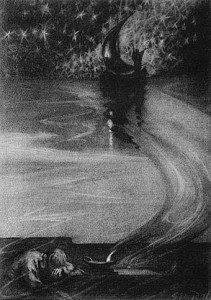 Blessed John Newman’s poem “The Dream of Gerontius” tells the story of a soul’s journey through death, and provides a meditation on the unseen world of Roman Catholic theology.
Blessed John Newman’s poem “The Dream of Gerontius” tells the story of a soul’s journey through death, and provides a meditation on the unseen world of Roman Catholic theology. 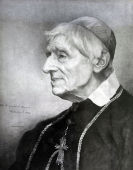
Click here for the full text of the poem
Gerontius (a name derived from the Greek word geron, “old man”) is a devout Everyman.Elgar’s setting uses most of the text of the first part of the poem, which takes place on Earth, but omits many of the more meditative sections of the much longer, otherworldly second part, tightening the narrative flow.
In the first part, we hear Gerontius as a dying man of faith, by turns fearful and hopeful, but always confident. A group of friends (also called “assistants” in the text) joins him in prayer and meditation. He passes in peace, and a priest, with the assistants, sends him on his way with a valediction. In the second part, Gerontius, now referred to as “The Soul”, awakes in a place apparently without space or time, and becomes aware of the presence of his guardian angel, who expresses joy at the culmination of her task (Newman conceived the Angel as male, but Elgar gives the part to a female singer). After a long dialogue, they journey towards the judgment throne.
They safely pass a group of demons, and encounter choirs of angels, eternally praising God for His grace and forgiveness. The Angel of the Agony pleads with Jesus to spare the souls of the faithful. Finally Gerontius glimpses God and is judged in a single moment. The Guardian Angel lowers Gerontius into the soothing lake of Purgatory, with a final benediction and promise of a re-awakening to glory. –wiki
Here is mezzo-soprano Sarah Connelly as the angel offering a beautiful version of “Softly and Gently” (which is the last passage of Edward Elgar’s musical oration of the “Dream of Gerontius”) as he is peacefully being placed into the lake of Purgatory. A stunning work and meditation for this or any day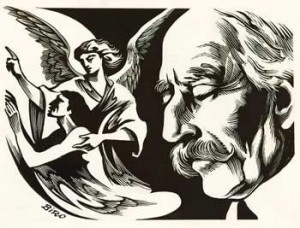
.
SOFTLY and gently, dearly-ransomed soul,
In my most loving arms I now enfold thee,
And, o’er the penal waters, as they roll
I poise thee, and I lower thee, and hold thee.
And carefully I dip thee in the lake,
And thou, without a sob or a resistance,
Dost through the flood thy rapid passage take,
Sinking deep, deeper, into the dim distance.
Angels, to whom the willing task is given,
Shall tend, and nurse, and lull thee, as thou liest;
And Masses on the earth and prayers in heaven,
Shall aid thee at the Throne of the most Highest
Farewell, but not forever! Brother dear,
Be brave and patient on thy bed of sorrow;
Swiftly shall pass thy night of trial here,
And I will come and wake thee on the morrow.
.
Tags: catholic, catholic podcast, catholic prayer, cathollc spirituality, choirs of angels, dream of gerontius, edward elgar, grace and forgiveness, john newman, roman catholic theology
This entry was posted on Wednesday, November 2nd, 2011 at 12:02 am
You can follow any responses to this entry through the RSS 2.0 feed.
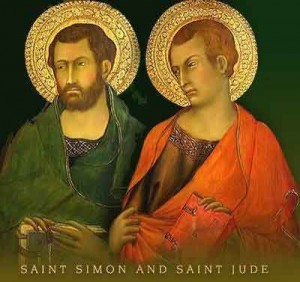 Why is this feast day of the two apostles celebrated together…Simon the Zealot and Jude, patron of the impossible? Through Jesus, with Jesus, in Jesus, all things are possible!
Why is this feast day of the two apostles celebrated together…Simon the Zealot and Jude, patron of the impossible? Through Jesus, with Jesus, in Jesus, all things are possible!
Tags: catholic, catholic podcast, catholic prayer, cathollc spirituality, Jesus, st. jude
This entry was posted on Friday, October 28th, 2011 at 7:16 am
You can follow any responses to this entry through the RSS 2.0 feed.
“Dispose the day…” OK, I really didn’t understand the significance of St. Crispin and St. Crispinian except for their presence in the robust guy “band of brothers” speech from Shakespeare’s Henry V…very macho “rouse the troops” moment in the play… I just figured they were warriors too…(besides I’m more of a  “Midsummer Night’s Dream” kind of Shakespeare girl anyway…)
                         Â
 That is until I read Omar F. A. Gutierrez’s fantastic blog post bringing it all together! Treat your brain and heart by visiting his blog  Regnum Novum
That is until I read Omar F. A. Gutierrez’s fantastic blog post bringing it all together! Treat your brain and heart by visiting his blog  Regnum Novum
Here, once again, is Omar Guiterrez breaking open for Discerning Hearts the beauty of Catholic Social Doctrine….
(it’s amazing where you can find it if you have eyes to see and ears to hear)
Today marks the feast of Saints Crispin and Crispian, brothers who were martyred by beheading in Rome sometime during the reign of the Emperor Diocletian (emperor from 284-305 AD).
That the saints lived is certainly true. The story of these brothers, however, comes to us from a late account that has little to suggest it’s authenticity. Generally, though, we know them to be from Rome, to have worked in Soissons, Gaul (now France), and to have been shoemakers thus earning them the title of patrons for shoemakers, cobblers, and those who work with leather.
The tale is that these two brothers, perhaps twins of noble blood, caught up in the zealous care for their faith and in love for Christ, left Rome in the 3rd century in order to spread the Gospel in Gaul. They took up the trade of the shoemaker and would not charge the poor who requested their services. By their example, and not, it seems,by any grand preaching, these two were good witnesses to the faith and converted many. When Maximian was appointed co-emperor in 285 and came to Gaul, the brothers were accused and brought before a character named Rictiovarus, whom we don’t exactly know existed but whose seathing hatred for Christians is legendary. At any rate, they were tortured mercilessly, but when the attempt to kill the saintly brothers through drowning and burning failed, Rictiovarus was driven into such a desperate fury that he threw himself into the fire prepared for the brothers thus killing himself. Eventually, Crispin and Crispian were beheaded which is a very effective way of killing someone…unless you’re St. Winifred, in which case that might not always work.  There are several things I’d like to draw out about these saints.
The first is that it was on this day 595 years ago (1415) that King Henry V led his horribly outnumbered English army into battle against the French at Agincourt, the battle so wonderfully remember today for the speech written by Shakespeare in Henry V,( a version of which can be seen above with Kenneth Branagh.)
The second thing is this, brought out in an edition of Butler’s Lives of the Saints, namely that Sts. Crispin and Crispian are a wonderful reminder that sanctity is not only for the cloistered hermit who has removed himself from society. These two never embarked on some large speaking tour throughout Gaul. They did not write any large tomes explicating the faith for the masses. They are not known for levitating or bilocation or magically producing shoes no one today can replicate with all our modern technology. No, they were simply saintly shoemakers. They were holy artisans is all, and this is a good thing. In this way they are almost the perfect patron saints for laborers, heroes of the Social Doctrine of the Church.
I’m reminded of a line from the Part I Chapter 3 of St. Francis de Sales’ classic Introduction to the Devout Life where he says:
 It is an error, nay more, a very heresy, to seek to banish the devout life from the soldier’s guardroom, the mechanic’s workshop, the prince’s court, or the domestic hearth. Of course a purely contemplative devotion, such as is specially proper to the religious and monastic life, cannot be practised in these outer vocations, but there are various other kinds of devotion well-suited to lead those whose calling is secular, along the paths of perfection. The Old Testament furnishes us examples in Abraham, Isaac and Jacob, David, Job, Tobias, Sarah, Rebecca and Judith; and in the New Testament we read of St. Joseph, Lydia and Crispus, who led a perfectly devout life in their trades:–we have S. Anne, Martha, S. Monica, Aquila and Priscilla, as examples of household devotion, Cornelius, S. Sebastian, and S. Maurice among soldiers;–Constantine, S. Helena, S. Louis, the Blessed Amadaeus, 2 and S. Edward on the throne. And we even find instances of some who fell away in solitude,– usually so helpful to perfection,–some who had led a higher life in the world, which seems so antagonistic to it. S. Gregory dwells on how Lot, who had kept himself pure in the city, fell in his mountain solitude. Be sure that wheresoever our lot is cast we may and must aim at the perfect life.
Sanctity can be found through the work which God has given us no matter what that might be. Indeed it is to be found in the guardroom, in the shop, in the court, in the home. This is the message of the Social Teaching of the Catholic Church. Sanctity and evangelization can be found through the labor of everyday life. It is less what you do than the way you do it, and the way to do anything is with the love of Christ.
Third, I want to point out that with saints whose stories are in doubt it can be tempting to write them off as the incipient pap of bygone days. There are some who actually claim that the Church has managed its control over the laity throughout the centuries by inventing such stories. I’m not making that claim, but many are tempted to think that there never was such a saint, or that we cannot glean any lesson from them, or that, poor bumpkins that they were, those ignoramuses of the early years of the Church meant well if they weren’t always truthful. This sort of temptation is what Chesterton called “chronological snobbery.†Somehow we image that in our Enlightened age we appreciate truth much more than the people of the early centuries. This would be a terrible mistake.
Stories do evolve over time, and tales can be embellished but we should never forget three things: first, that the stories were told because of some real event or real person, even if we don’t remember their name and even if our collective memories have gotten the details wrong. Second, the miraculous is not impossible. We believe in things seen and unseen, so why presume the fantastical must be unreal? Third, someone in heaven answers to the name of these saints in question. That’s what matters.  – Regnum Novum
Thanks Omar! My visits to DSW will never be the same again.
Tags: catholic, catholic podcast, catholic prayer, catholic social doctrine, cathollc spirituality, christians, emperor diocletian, guiterrez, henry v, st crispin
This entry was posted on Tuesday, October 25th, 2011 at 10:16 am
You can follow any responses to this entry through the RSS 2.0 feed.
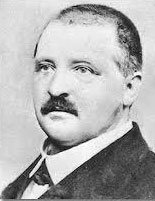 Â VATICAN CITY, 22 OCT 2011 (VIS) – This evening in the Vatican’s Paul VI Hall, the Bavarian State Opera gave a concert in honour of Benedict XVI. The programme included the Ninth Symphony and the “Te Deum” by Anton Bruckner, played by the Bavarian State Orchestra and the “Audi Jugendchorakademie”, conducted respectively by Kent Nagano and Martin Steidler.
 VATICAN CITY, 22 OCT 2011 (VIS) – This evening in the Vatican’s Paul VI Hall, the Bavarian State Opera gave a concert in honour of Benedict XVI. The programme included the Ninth Symphony and the “Te Deum” by Anton Bruckner, played by the Bavarian State Orchestra and the “Audi Jugendchorakademie”, conducted respectively by Kent Nagano and Martin Steidler.
At the end of the performance the Pope rose to thank the musicians.
Listening to Bruckner’s music, he said, “is like finding oneself in a great cathedral, surrounded by its imposing structures which arouse emotion and lift us to the heights. There is however an element that lies at the foundations of Bruckner’s music, both the symphonic and the sacred: the simple, solid, genuine faith he conserved throughout his life”.
“The great conductor Bruno Walter used to say that ‘Mahler always sought after God, while Bruckner had found Him’. The symphony we have just heard has a very specific title: ‘Dem lieben Gott’ (To the Beloved God), almost as if he wished to dedicate and entrust the last and most mature fruit of his art to the One in Whom he had always believed, the One Who had become his only true interlocutor in the last stage of his life”, the Holy Father said.
“Bruckner asked this beloved God to let him enter His mystery, … to let him praise the Lord in heaven as he had on earth with his music. ‘Te Deum laudamus, Te Dominum confitemur’; this great work we have just heard – written at one sitting then reworked over fifteen years as if reconsidering how better to thank and praise God – sums up the faith of this great musician”, Pope Benedict concluded.
“It is also a reminder for us to open our horizons and think of eternal life, not so as to escape the present, though burdened with problems and difficulties, but to experience it more intensely, bringing a little light, hope and love into the reality in which we live”.
Tags: catholic, catholic podcast, catholic prayer, cathollc spirituality, sacred music
This entry was posted on Monday, October 24th, 2011 at 12:16 pm
You can follow any responses to this entry through the RSS 2.0 feed.
‘The love of Christ arouses us, urges us to run, and to fly lifted on the wings of holy zeal . . . The man who burns with the fire of divine love is a son of the Immaculate Heart of Mary, and wherever he goes, he enkindles that flame; he desires and works with all his strength to inflame all men with the fire of God’s love. Nothing deters him: he rejoices in poverty; he labors strenuously; he welcomes hardships; he laughs off false accusations; he rejoices in anguish. He thinks only of how he might follow Jesus Christ and imitate Him by his prayers, his labors, his sufferings, and by caring always and only for the glory of God and the salvation of souls.’ – St. Anthony Mary Claret
A remarkable saint…St. Anthony Mary Claret who lived during the turblent years of the 1800’s in Latin America, namely Cuba. He had a great love for the Blessed Virgin Mary and her Immaculate Heart. More on his life can be found here…
Tags: anthony mary claret, blessed virgin mary, catholic, catholic podcast, catholic prayer, cathollc spirituality, Church, immaculate heart of mary, jesus christ, latin america, love, St. Anthony Mary, St. Anthony Mary Claret, sufferings
This entry was posted on Monday, October 24th, 2011 at 12:52 am
You can follow any responses to this entry through the RSS 2.0 feed.
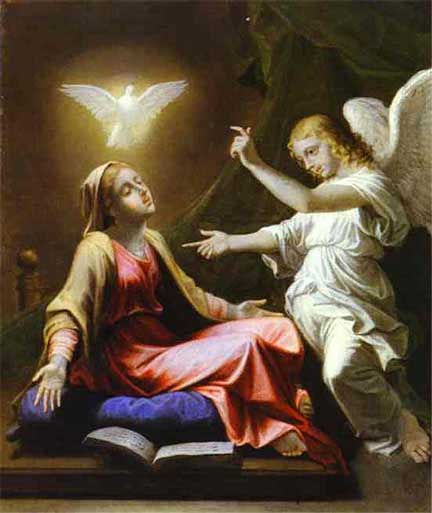 The lyrics and translation are as follows:
The lyrics and translation are as follows:
Hail Mary, full of grace, the Lord is with thee.
Blessed art thou amongst women, and blessed is the fruit of thy womb, Jesus.
Holy Mary, Mother of God, pray for us sinners, now and at the hour of our death.
Amen
Ãve MarÃa, grátia pléna, Dóminus técum.
BenedÃcta tu in muliéribus, et benedÃctus frúctus véntris túi, Iésus.
Sáncta MarÃa, Máter Déi, óra pro nóbis peccatóribus, nunc et in hóra mórtis nóstrae.
Ãmen.
Tags: catholic, Catholic Hymns of Praise, catholic podcast, catholic prayer, cathollc spirituality, death, hail mary, Holy Mary, women
This entry was posted on Sunday, October 23rd, 2011 at 12:06 am
You can follow any responses to this entry through the RSS 2.0 feed.
Here is Pope Benedict XVI’s homily for the Mass of beatification:
Dear Brothers and Sisters,
Six years ago we gathered in this Square to celebrate the funeral of Pope John Paul II. Our grief at his loss was deep, but even greater was our sense of an immense grace which embraced Rome and the whole world: a grace which was in some way the fruit of my beloved predecessor’s entire life, and especially of his witness in suffering. Even then we perceived the fragrance of his sanctity, and in any number of ways God’s People showed their veneration for him. For this reason, with all due respect for the Church’s canonical norms, I wanted his cause of beatification to move forward with reasonable haste. And now the longed-for day has come; it came quickly because this is what was pleasing to the Lord: John Paul II is blessed!….
Today is the Second Sunday of Easter, which Blessed John Paul II entitled Divine Mercy Sunday. The date was chosen for today’s celebration because, in God’s providence, my predecessor died on the vigil of this feast. Today is also the first day of May, Mary’s month, and the liturgical memorial of Saint Joseph the Worker. All these elements serve to enrich our prayer, they help us in our pilgrimage through time and space; but in heaven a very different celebration is taking place among the angels and saints! Even so, God is but one, and one too is Christ the Lord, who like a bridge joins earth to heaven. At this moment we feel closer than ever, sharing as it were in the liturgy of heaven.
….
Dear brothers and sisters, today our eyes behold, in the full spiritual light of the Risen Christ, the beloved and revered figure of John Paul II. Today his name is added to the host of those whom he proclaimed saints and blesseds during the almost twenty-seven years of his pontificate, thereby forcefully emphasizing the universal vocation to the heights of the Christian life, to holiness, taught by the conciliar Constitution on the Church Lumen Gentium. All of us, as members of the people of God – bishops, priests, deacons, laity, men and women religious – are making our pilgrim way to the heavenly homeland where the Virgin Mary has preceded us, associated as she was in a unique and perfect way to the mystery of Christ and the Church. Karol WojtyÅ‚a took part in the Second Vatican Council, first as an auxiliary Bishop and then as Archbishop of Kraków. He was fully aware that the Council’s decision to devote the last chapter of its Constitution on the Church to Mary meant that the Mother of the Redeemer is held up as an image and model of holiness for every Christian and for the entire Church. This was the theological vision which Blessed John Paul II discovered as a young man and subsequently maintained and deepened throughout his life. A vision which is expressed in the scriptural image of the crucified Christ with Mary, his Mother, at his side.This icon from the Gospel of John (19:25-27) was taken up in the episcopal and later the papal coat-of-
arms of Karol WojtyÅ‚a: a golden cross with the letter “M” on the lower right and the motto “Totus tuus”, drawn from the well-known words of Saint Louis Marie Grignion de Montfort in which Karol WojtyÅ‚a found a guiding light for his life: “Totus tuus ego sum et omnia mea tua sunt. Accipio te in mea omnia. Praebe mihi cor tuum, Maria – I belong entirely to you, and all that I have is yours. I take you for my all. O Mary, give me your heart” (Treatise on True Devotion to the Blessed Virgin, 266).
In his Testament, the new Blessed wrote: “When, on 16 October 1978, the Conclave of Cardinals chose John Paul II, the Primate of Poland, Cardinal Stefan WyszyÅ„ski, said to me: ‘The task of the new Pope will be to lead the Church into the Third Millennium'”. And the Pope added: “I would like once again to express my gratitude to the Holy Spirit for the great gift of the Second Vatican Council, to which, together with the whole Church – and especially with the whole episcopate – I feel indebted. I am convinced that it will long be granted to the new generations to draw from the treasures that this Council of the twentieth century has lavished upon us. As a Bishop who took part in the Council from the first to the last day, I desire to entrust this great patrimony to all who are and will be called in the future to put it into practice. For my part, I thank the Eternal Shepherd, who has enabled me to serve this very great cause in the course of all the years of my Pontificate”. And what is this “cause”? It is the same one that John Paul II presented during his first solemn Mass in Saint Peter’s Square in the unforgettable words: “Do not be afraid! Open, open wide the doors to Christ!”
What the newly-elected Pope asked of everyone, he was himself the first to do: society, culture, political and economic systems he opened up to Christ, turning back with the strength of a titan – a strength which came to him from God – a tide which appeared irreversible. By his witness of faith, love and apostolic courage, accompanied by great human charisma, this exemplary son of Poland helped believers throughout the world not to be afraid to be called Christian, to belong to the Church, to speak of the Gospel. In a word: he helped us not to fear the truth, because truth is the guarantee of liberty. To put it even more succinctly: he gave us the strength to believe in Christ, because Christ is Redemptor hominis, the Redeemer of man. This was the theme of his first encyclical, and the thread which runs though all the others.
When Karol WojtyÅ‚a ascended to the throne of Peter, he brought with him a deep understanding of the difference between Marxism and Christianity, based on their respective visions of man. This was his message: man is the way of the Church, and Christ is the way of man. With this message, which is the great legacy of the Second Vatican Council and of its “helmsman”, the Servant of God Pope Paul VI, John Paul II led the People of God across the threshold of the Third Millennium, which thanks to Christ he was able to call “the threshold of hope”. Throughout the long journey of preparation for the great Jubilee he directed Christianity once again to the future, the future of God, which transcends history while nonetheless directly affecting it. He rightly reclaimed for Christianity that impulse of hope which had in some sense faltered before Marxism and the ideology of progress. He restored to Christianity its true face as a religion of hope, to be lived in history in an “Advent” spirit, in a personal and communitarian existence directed to Christ, the fullness of humanity and the fulfillment of all our longings for justice and peace.
Finally, on a more personal note, I would like to thank God for the gift of having worked for many years with Blessed Pope
John Paul II. I had known him earlier and had esteemed him, but for twenty-three years, beginning in 1982 after he called me to Rome to be Prefect of the Congregation for the Doctrine of the Faith, I was at his side and came to revere him all the more. My own service was sustained by his spiritual depth and by the richness of his insights. His example of prayer continually impressed and edified me: he remained deeply united to God even amid the many demands of his ministry. Then too, there was his witness in suffering: the Lord gradually stripped him of everything, yet he remained ever a “rock”, as Christ desired. His profound humility, grounded in close union with Christ, enabled him to continue to lead the Church and to give to the world a message which became all the more eloquent as his physical strength declined. In this way he lived out in an extraordinary way the vocation of every priest and bishop to become completely one with Jesus, whom he daily receives and offers in the Church.
Blessed are you, beloved Pope John Paul II, because you believed! Continue, we implore you, to sustain from heaven the faith of God’s people. You often blessed us in this Square from the Apostolic Palace: Bless us, Holy Father! Amen.
Tags: catholic, catholic podcast, catholic prayer, cathollc spirituality, pope benedict xvi, pope john paul ii, Second Vatican Council, virgin mary
This entry was posted on Saturday, October 22nd, 2011 at 6:55 am
You can follow any responses to this entry through the RSS 2.0 feed.
Join Fr. Joseph Michael Mary as he reflects upon the Message of Our Lady of Fatima and the dogma of Purgatory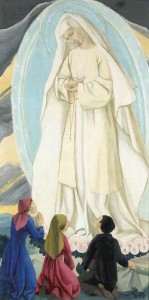
Tags: catholic, catholic podcast, catholic prayer, cathollc spirituality, confession, fatima, Fatima Reflections, Joseph Michael Mary, our lady of fatima, purgatory, reconciliation
This entry was posted on Saturday, October 22nd, 2011 at 12:01 am
You can follow any responses to this entry through the RSS 2.0 feed.
St. Paul of the Cross quotes:
When you feel the assaults of passion and anger, then is the time to be silent as Jesus was silent in the midst of His ignominies and sufferings.-St. Paul of the Cross
It is very good and holy to consider the passion of our Lord, and to meditate on it, for by this sacred path we reach union with God. In this most holy school we learn true wisdom, for it was there that all the saints learned it.-St. Paul of the Cross
Therefore, be constant in practicing every virtue, and especially in imitating the patience of our dear Jesus, for this is the summit of pure love. Live in such a way that all may know that you bear outwardly as well as inwardly the image of Christ crucified, the model of all gentleness and mercy. For if a man is united inwardly with the Son of the living God, he also bears his likeness outwardly by his continual practice of heroic goodness, and especially through a patience reinforced by courage, which does not complain either secretly or in public. Conceal yourselves in Jesus crucified, and hope for nothing except that all men be thoroughly converted to his will.-St. Paul of the Cross
I want to set myself on fire with love…I want to be entirely on fire with love…and I want to know how to sing in the fire of love.-St. Paul of the Cross
Look upon the face of the Crucified, who invites you to follow Him. He will be a Father, Mother–everything to you.-St. Paul of the Cross
I hope that God will save me through the merits of the Passion of Jesus. The more difficulties in life, the more I hope in God. By God’s grace I will not lose my soul, but I hope in His mercy.-St. Paul of the Cross
Christ Crucified is a work of love. The miracle of miracles of love. The most stupendous work of the love of God. The bottomless sea of the love of God, where virtues are found, where one can lose oneself in love and sorrow. A sea and a fire or a sea of fire. The most beneficial means of abandoning sin and growing in virtue, and so in holiness.-St. Paul of the Cross
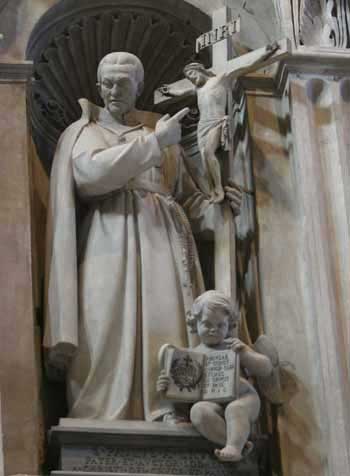 At holy Communion I had much sweetness. My dear God gave me infused knowledge of the joy which the soul will have when we see him face to face, when we will be united with Him in holy love. Then I felt sorrow to see Him offended and I told Him that I would willingly be torn to pieces for a single soul. Indeed, I felt that I would die when I saw the loss of so many souls who do not experience the fruit of the Passion of Jesus.-St. Paul of the Cross
At holy Communion I had much sweetness. My dear God gave me infused knowledge of the joy which the soul will have when we see him face to face, when we will be united with Him in holy love. Then I felt sorrow to see Him offended and I told Him that I would willingly be torn to pieces for a single soul. Indeed, I felt that I would die when I saw the loss of so many souls who do not experience the fruit of the Passion of Jesus.-St. Paul of the Cross
Oh my good God, how gentle You are! How sweet You are! Oh dear cross, I embrace you and press you to my heart!-St. Paul of the Cross
May the mercy of God grant you still more time in life so that you can become completely crucified with the Divine Spouse by means of mystical death, death to everything that is not God, with a continual detachment from all created things, wholly concealed in the divine bosom of the celestial Father in true inner solitude. Do not live any longer in yourself, but let Jesus Christ live in you in such a way that the virtue of this Divine Savior may be resplendent in all your actions, in order that all may see in you a true portrait of the Crucified and sense the sweetest fragrance of the holy virtues of the Lord, in interior and exterior modesty, in patience, in gentleness, suffering, charity, humility, and in all others that follow. -St. Paul of the Cross
Tags: catholic, catholic podcast, catholic prayer, cathollc spirituality, mystic, mystic of the Church, passion of christ, paul of christ, Paul of the Cross, Saint Paul, st, st. paul, the passionist
This entry was posted on Thursday, October 20th, 2011 at 12:09 am
You can follow any responses to this entry through the RSS 2.0 feed.
VATICAN CITY, 19 OCT 2011 (VIS) –
Some 20,000 pilgrims attended Benedict XVI’s general audience, which was held this morning in St. Peter’s Square. Continuing a series of catecheses dedicated to the Psalms, the Holy Father focused his attention on Psalm 136, “a great hymn of praise which celebrates the Lord in the many and repeated manifestations of His goodness down human history”.
The Pope explained how, in Jewish tradition, this Psalm is sung at the end of the Passover supper, and therefore it was probably also pronounced by Jesus at the last Passover He celebrated with His disciples. The text enumerates God’s many interventions in favour of His people “and each proclamation of a salvific action by the Lord is answered by an antiphon reiterating the main cause for praise: God’s eternal love, a love which, according to the Hebrew term used, implies faithfulness, mercy, goodness, grace and tenderness”.
God is first presented as “He Who ‘does great wonders’, first among them that of the creation: heaven, earth and stars. … With the creation the Lord shows Himself in all His goodness and beauty. He commits Himself to life, revealing a desire for good whence all other salvific actions arise”.
The Psalm goes on to consider God’s manifestations in history, evoking the great moment when the Israelites were freed from slavery in Egypt. The forty years of wandering in the desert were “a decisive period for Israel which, allowing itself to be guided by the Lord, learned to live on faith, obedient and docile to the laws of God. Those were difficult years, marked by the harshness of life in the desert, but also a happy time of confidence and filial trust in the Lord”.
“The history of Israel has known exhilarating moments of joy, of fullness of life, of awareness of the presence of God and His salvation”, said the Pope. “But it has also been marked by episodes of sin, painful periods of darkness and profound affliction. Many were the adversaries from whom the Lord liberated His people”. The Psalm speaks of these events, in particular the Babylonian exile and the destruction of Jerusalem, “when it seemed that Israel had lost everything, even its own identity, even its trust in the Lord. However, God remembers, and frees. The salvation of Israel and of all mankind is bound to the Lord’s faithfulness, to His memory. While man forgets easily, God remains faithful: His memory is a precious casket containing that ‘love which endures forever’ about which our Psalm speaks”.
The Psalm concludes by reminding us that God feeds His creatures, “caring for life and giving
bread. … In the fullness of time the Son of God became man to give life, for the salvation of each one of us; and He continues to gives Himself as bread in the mystery of the Eucharist, so as to draw us into His covenant, which makes us children. So great is God’s merciful goodness, the sublimity of His ‘love which endures forever'”. In conclusion the Pope read a quote from the First Letter of St. John, advising the faithful to bear it in mind in their prayers: “See what love the Father has given us, that that we should be called children of God; and that is what we are”.
AG/ VIS 20111019 (560)Â
raise the Lord, for he is good: for his mercy endures for ever.
2 Praise the God of gods: for his mercy endures for ever.Â
3 Praise the Lord of lords: for his mercy endures for ever.Â
4Â Who alone does great wonders: for his mercy endures for ever.Â
5 Who made the heavens in understanding: for his mercy endures for ever.
6Â Who established the earth above the waters: for his mercy endures for ever.
 7 Who made the great lights: for his mercy endures for ever.Â
8Â The sun to rule the day: for his mercy endures for ever.Â
9Â The moon and the stars to rule the night: for his mercy endures for ever.Â
10 Who smote Egypt with their firstborn: for his mercy endures for ever.Â
11 Who brought out Israel from among them: for his mercy endures for ever.Â
12Â With a mighty hand and with a stretched out arm: for his mercy endures for ever.Â
13 Who divided the Red Sea into parts: for his mercy endures for ever.
14 And brought out Israel through the midst thereof: for his mercy endures for ever.Â
15 And overthrew Pharao and his host in the Red Sea: for his mercy endures for ever.Â
16 Who led his people through the desert: for his mercy endures for ever.Â
17Â Who smote great kings: for his mercy endures for ever.Â
18Â And slew strong kings: for his mercy endures for ever.Â
19 Sehon king of the Amorrhites: for his mercy endures for ever.Â
20Â And Og king of Basan: for his mercy endures for ever.Â
21Â And he gave their land for an inheritance: for his mercy endures for ever.Â
22 For an inheritance to his servant Israel: for his mercy endures for ever.Â
23Â For he was mindful of us in our affliction: for his mercy endures for ever.
24 And he redeemed us from our enemies: for his mercy endures for ever.Â
25Â Who gives food to all flesh: for his mercy endures for ever.Â
26 Give glory to the God of heaven: for his mercy endures for ever. Give glory to the Lord of lords: for his mercy endures for ever.
Tags: catholic, catholic podcast, catholic prayer, cathollc spirituality, Israel, pope benedict, pope benedict xvi, prayer, psalm 136
This entry was posted on Wednesday, October 19th, 2011 at 4:02 pm
You can follow any responses to this entry through the RSS 2.0 feed.


